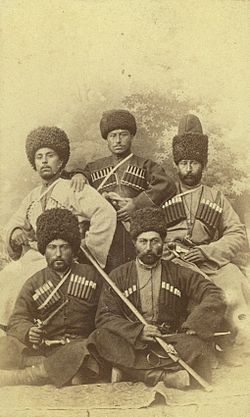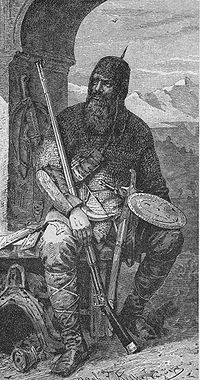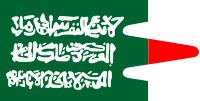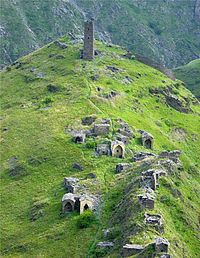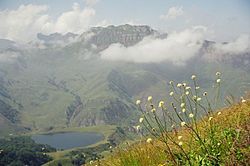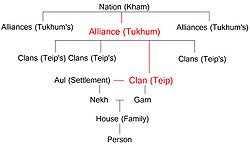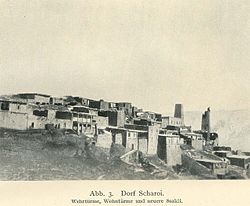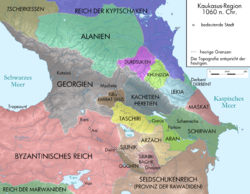- Nakh peoples
-
Nakh peoples are a group of historical and modern ethnic groups speaking (or historically speaking) Nakh languages and sharing certain cultural traits. In modern days, they reside almost completely in the North Caucasus, but historically large areas of the South Caucasus may have also been Nakh.
The only healthy, living branch of the Nakh languages are now the Vainakh languages (spoken by the Vainakh peoples, namely Chechens, Ingush and Georgian Kist), due to the extinction of other peoples. The only non-Vainakh modern Nakh people are the Bats people in Northeast Georgia, but they are largely assimilated and their language is highly endangered.
Although the Vainakh are only a branch of Nakh peoples, due to the present day situation where the only well-known Nakh are Vainakh, the words Vainakh and Nakh are frequently confused. Hence the word Vainakh is mistakenly applied to historical non-Vainakh frequently.
Contents
History
Prehistory
The early history of the Nakh peoples has been tentatively reconstructed from linguistic analysis and archaeological evidence.
- 10,000-8000 BC
- People speaking a language ancestral to the Northeast Caucasian languages migrated from the Fertile Crescent to the slopes of the Caucasus bringing domesticated animals, crops, and irrigation.[1]
- 6000-4000 BC
- Pottery was introduced to the region. Neolithic settlements near Ali-Yurt and Magas yielded clay dishes polished and drilled stones, and stone tools (such as axes and knives). Remains of settlements made out of clay bricks were found in the plains. Settlements with "cyclopean" stone walls and buildings were found in the mountains (at Doshkhakle, Kart, and other places), some of them dating to 8000 BC.[2]
- 4th century BC-11th century AD
- The mountain clans founded an association of clans called Durzukia, which survived into the early Middle Ages despite incursions by Khazars, Huns, Arabs, Persians, Mongols and others. The first mention of the name "durdzuki" according to the writing of the Arab writer Ibn al-Faqih and al-Baladzori falls into the first half of the 6th century, stating "the construction of Chosroes Anushirvanom (VI) in Durzukia 12 gates and stone fortifications.[3] Georgian source Kartlis Tskhovreba clearly states that Durzuks paid tribute to the Khazars[citation needed][page needed].
- 7th-11th centuries
- State of Serir[citation needed]
- 12th-15th centuries
- the State of Simsir was a union of Vainakh teips. They started a national struggle of liberation from the Golden Horde.[4] After the Mongol invasion Islam started its spread in the region.[5] The spread of Islam seems to have started in the lowland part of the Vainakh states at this time, associated with the advent of the Arabic language and Arabic writing. Inscriptions on monuments from this time, preserved in some Vainakh villages, also testify to this.[6]
- 13th-14th centuries
- Independence wars against Tatar-Mongol hordes and army of Tamerlane.
- 17th century to nowadays
- ongoing struggle between Chechens and Russians over the independence of what is Chechnya to the Russians, but Ichkeria to Chechens; Ingush remain less openly rebellious, but still have a particularly problematic conflict with the Ossetes ; Batsbi and Kists are considered Georgians and are part of Georgia (living mainly in the Tusheti region)
- 1829-1859
- Caucasian Imamate
Architecture
Towers
Main article: Nakh ArchitectureA characteristic feature of Vainakh architecture in the Middle Ages, rarely seen outside Chechnya and Ingushetia, was the Vainakh tower, a kind of multi-floor structure that was used for dwelling or defense (or both). Nakh tower architecture and construction techniques reached their peak in the 15th–17th centuries.[7]
Residential towers had two or three floors, supported by a central pillar of stone blocks, and were topped with a flat shale roofing. These towers have been compared to the prehistoric mountain settlements dating back to 8000 BC.
Military ("combat") towers were 25 meter high or more,[7] with four of five floors and a square base approximately six meters wide. Access to the second floor was through a ladder. The defenders fired at the enemy through loopholes and the top of the tower had mashikul – overhanging small balconies without a floor. These towers were usually crowned with pyramid-shaped roofing built in steps and topping with a sharpened capstone.
Buildings combining the functions of residential and military towers were intermediate in size between the two types, and had loop-holes and mashikuls.
Nakh towers used to be sparingly decorated with religious or good-wishing petrographs, such as solar signs or depictions of the author’s hands, animals, etc.. Military towers often bore a Golgopha cross.
Sanctuaries, temples and mosques
The Vainakh pagan pantheon included a supreme god Dela and a goddess of fertility Tusholi. There were also phallic cults.
A whole number of peculiar monuments, natural and artificial, served as shrines for ritual services. Vainakhs[clarification needed] chose mountains (such as the Tsei-Lam Range), lakes (Galanchoge-Ami) and some species of plants, pear-trees in particular, for exercising rituals. These shrines were places for prayers and for the sacrifice of domestic animals.
The most primitive shrines (sielingi) were low rectangular pillar-shaped stone structures with a niche for candles. These shrines were raised on the village outskirts and at the graveyards to protect both the living and the dead. Better known are shrines in the form of small houses topped with ridged step roofing, like Myatsil Sanctuary on Mat-Lam Mountain near the town of Vladikavkaz. Such a large range of shrines belonging to
Beginning from the 11th – 12th century, Georgian Christian influence on the Nakh tribes are attested, for example, by the Tkhaba-Yerdy Church consecrated to St. Thomas in Assa Valley, and extant churches in Ingushetia.
Islamic influence intensified in 18th and 19th centuries. Examples of Islamic architecture from that period are the tower-shaped mosques in the villages of Makazhoi and Khimoi.
Necropoles
Burial vaults or crypts remained from the pagan period in the history of Vainakhs, before they accepted Islam in the 16th century (partially, the entire region, Islam has spread only in the 17th century.). They were built either a bit deepening into the ground or half underground and on the surface. The latter formed whole “towns of the dead” on the outskirts of the villages and reminded sanctuaries from the outside, with a dummy vaults constructed of overlapping stones. The deceased were placed on the special shelves in the crypts, in clothes and decorations and arms.
The general Islamic rituals established burials with the further penetration of Islam inside the mountainous regions of Chechnya and Ingushetia. Stone steles, churts, inscribed with prayers and epitaphs, began to be erected at the graves and more prosperous mountaineers were honoured with mausoleums after death. The Borgha-Kash Mausoleum dating to the very beginning of 15th century and built for a Noghai prince is a good example of these.
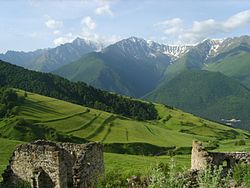 Ruins of ancient Vainakh settlement, and agricultural terraces behind.
Ruins of ancient Vainakh settlement, and agricultural terraces behind.
Agricultural structures
Lack of arable land in sufficient quantities in the mountainous areas, forced Vainakhs to use their territory of residence as efficiently as possible. They leveled the steep slopes, organized terraces suitable for agriculture. On the barren rocky slopes of rocks, which are unsuitable for agriculture Vainakhs hew foundations for terraces. On carts harnessed donkeys and oxen, they brought black soil of the lowlands, and filled with it artificial terraces.[8] For maximum harvest was organized by the entire irrigation system, which consisted of a small artificial stream canals connected with the mountain rivers, these canals were called Taatol, they also built a small stone canals called Epala, and quite small wooden troughs Aparri. Some scholars notably I. Diakonov and S. Starostin proposed that Epala and Aparri may correspond to Urartian irrigation canal name "pili" and Hurrian "pilli/a".[9] Some irrigation structures were built also on lowlands but they were less complicated.
Language
Economy in the Middle Ages
Agriculture
Animal husbandry
Trade
Crafts
Vehicles
Сarts and carriages made Vainakh masters were highly valued in the region and beyond. Products of Vainakh masters bought not only the Caucasian peoples, but also such excess power with an established industry like Russia. To support non-competitive domestic producers, Russia, overlaid Vainakh manufacturers of large fees. At this complaining Terek Cossacks in their letters to Russian Government, despite the fact that they are a natural enemy of the tree.[10] In 1722 the Russian Army bought 616 Vehicles for 1308 rubles, at a time when the annual salary of the governor of the three villages was only 50 rubles.[11][12]
Carpet weaving
Since ancient times, the Vainakhs have been producing thin felt carpets called Istang. Vainakh rugs are distinguished by a peculiar pattern and high quality. Jacob Reineggs, who visited the region in the 18th century, noticed that Chechen and Ingush women skillfully manufactured carpets and fringes.[13] Ornamen Vainakh carpets were divided among themselves into different groups dependent on patterns;
- Сarpet with colorful ornaments (Chechen: Khorza istang)
- Rug with fringe (Chechen: Khinja yolu istang)
- Plain rug, without any decorations or ornaments.
- Thick floor rugs (Chechen: Kuuz)
- Expensive wall carpet (Chechen: Pals)
Mythology
Main article: Vainakh mythologyOnly a few fragments of Vainakh mythology have survived to modern times. These fragments consist of the names of deities personifying elements of animist ideas, Nart saga, cosmogonic tradition, remnants of stock-breeding and landtilling, totemic beliefs and folk calendar.[14]
Legends
The greatest samples of Nakh mythology are the legends of Pkharmat, Galanchoge Lake, the epic war of Pkhagalberi (hare riders) dwarves against Narts, Kezanoi Lake, and myths about how sun moon and stars appeared.[15]
The Nakh myth of the legendary Pkharmat being shackled on Mount Kazbek by God Sela because he has stolen heavenly fire from him shows some parallels with Greek Myth of Prometheus and Georgian Amirami. The Legendary war of Pkhalberi(hare riders) dwarves against Narts can be compared to Greek "Crane and Pygmies war" by Said-Magomed Khasiev [16] The Golden Fleece myth seems to be binded to Nakh 11 years calendar tradition. In such a myth, ram skin was placed in an oak frame "Jaar" for 11 years, and produced golden fleece named "Dasho Ertal".[17]
Legend of Kezanoi Lake
Legend has explicit parallels with Biblical Sodom and Gomorrah, and the Islamic Lot. The story tells us that there once there was a very rich settlement at the place where now there is a lake. Despite their wealth, the people of this city was very greedy. Once God Dela sent his representatives in the guise of beggars, to test people. They asked all residents to give them food, but residents of the city in response to abused and driven away, and only one poor family in the village shared with them their food.
Legend has it that a poor family left a burnt bread for himself and gave a white bread to her guests. Leaving the house, guests reported that after some time behind the front door will be collected in puddles. And when this happens they should gather the bare necessities, leave their home, and go to the mountains. Predicting unknown guests came to pass. Poor families do not disobeyed and did everything as they told the guests.
They said the rich of the impending disaster, and asked to follow them, but greed did not allow them to leave their treasures. In the evening the family watched the terrible catastrophe, they saw the water covers their house along with those who remained.In memory of terrible events Vainakhs named the lake, lake of sorrow and cruelty, Kezanoi lake.
Legend of Galanchoge Lake
Legend tells of an incident which occurred when two women decide to wash clothes in the sacred lake Galanchoge, which was the abode of Vainakh's supreme deity Dela's daughter Tusholi. In continuation of story insulted goddess punishes the offenders turning them into stones, all the same goddess could not remain in distorted lake. She has turned into a mythical bull, and began to destroy the settlements are located on the hillside. Disaster continued until the bull was tamed in the settlement located in place of new Galanchoge settlement. Vainakhs found use for the tamed animal, with its help they plowed their fields. But unfortunately the next spring in the fields that were plowed by sacred animal began to appear springs. The water flooded the fields and turned them into a lake, and Tusholi again turned her face and settled into a new clean abode.
Cosmology and creation
See also: Vainakh religionIn ancient Nakh cosmology universe was created by supreme god Dela. Earth, created in three years, was larger than heavens three times and was propped up on the gigantic bull horns. The realm of the Vainakh Gods was over the cloads. Ishar-Deela was the ruler of the subterranean world, Deeli-Malkhi. Deeli-Malkhi was larger than realm of the human, it took seven years to create it. Nakhs believed when sun sets in the west it goes to the netherworld and vice versa. Deeli-Malkhi wasn't an evil realm of dead or undead. It was almost similar to the upper world with some improvements in its social structures. There was no judgment in life after life. Dela-Malkh was sun god playing central role in religious celebrations. On 25 December Nakhs celebrated Sun Festival in honor of Sun Gods birthday.[18]
The names of stars and constellations were also connected to myths. So Vainakhs call:
- Milky Way the route of scattered straw (Chechen: Ča Taqina Tača)
- Great Bear the seven brothers’ seven stars (Chechen: Vorx Vešin Vorx Seda) meets 7 sons of the god of the universe Tq'a. In the Ingush version of the legend Pkharmat, seven sons Tq'a were punished by his wife Khimekhninen for help Magal, stealing fire from Tq'a. She lifted them up into the air, far from land that they have become the seven stars.
- Gemini (constellation) as (Chechen: Kovreģina Seda)
- Sirius, Betelgeuse and Procyon Nakhs named as Tripodstar (Chechen: Qokogseda)
- Orion as Evening star (Chechen: Märkaj Seda)
- Capricornus as Roofing towers (Chechen: Neģara Bjovnaš)
- Venus depending on daytime as sunset star and sunrise star. (Chechen: Sadov Seda) and (Chechen: Saxül Seda) The name of the star (planet) is (Chechen: Dilbat)
- Neptune as (Chechen: Ẋay)[citation needed]
Fairy tales
In Nakh fairy tales can be found people with supernatural abilities, magic artifacts, mythic animals as dragons and winged horses and some journeys to another worlds and magic. In almost all fairy tales good triumph over evil.
Religion
 Tkhaba-Erdy Temple in Ingushetia.
Tkhaba-Erdy Temple in Ingushetia.
In the Middle Ages Vainakh society felt a strong Byzantine influence that led to the adoption of Eastern Orthodox Christianity in some parts of the country (particularly the mountainous South). However, Christianity did not last long. After the devastation of the country by Tamerlane, Christianity was eroded (due to the temporary loss of contacts between Georgia and Nakh Christians) and gradually the Chechens and Ingush returned to their native pagan beliefs (while the Bats were permanently Christianized). Islam began to spread on Nakh peoples lands from 16th and 17th centuries.
Vainakhs are predominantly Muslim of Shafi`i school of thought of Sunni Islam.[19] The majority of Chechen (approx 1.5 million) and Ingush (500.000 people) people are Muslim of the Shafi`i school. Kists (about 7.100 people) are partly Sunni Muslims and Georgian Orthodox when Bats approx. 3.000 people are Christian (Georgian Orthodox) [19]
By rite, most Chechens are Qadiris, with a considerable Nakshbandi minority. There is also a tiny Salafi minority(Sunni sect).[20] The two main groups (Salafism is more of a modern introduction to the region, and is still considered to be completely foreign) have often had divergent responses to events (for example, the Qadiri authorities initially backing the Bolsheviks after the promised to grant freedom to the Chechens from Russia; while the Nakshbandis were more sceptical of the Bolsheviks' sincerity)
However, as is also the case with other Caucasian groups, such as the Georgians, Abkhaz, and Circassians, Islam did not wipe out all traces of the native religion. Many Chechens and Ingush even refer to the God of the Muslim religion (usually "Allah", from Arabic) as "Dela", who is the head god of the original Nakh pantheon (parallel to how Georgians refer to the Christian God as Ghmerti, their original main god). The Nakh interpretation of Sharia often is more resemblant of the adat than of sharia as practiced in other Muslim countries, though some note that this may actually be closer to the original intent in some ways. There is a common saying that "Muhammad may have been an Arab, but Allah is Chechen for sure", emphasizing this attitude towards the restrictive Islam of the Middle East that is often imagined in the West as representing the behavior and culture of all Muslims.[21][22] Despite syncretism, most Nakh peoples are often regarded as either "Muslim people" (in the case of Ingush, Kists and Chechens), or as "Orthodox Christian people" (Batsbi). Nonetheless, worship of the original pantheon, with the exception of Dela, for the most part has no modern continuity and was replaced by Islam, despite some syncretism (i.e. building mosques consistently near streams, where temples were, reverence for the adat, etc.).
There is considerable tension among Chechens about religion. This largely asserts itself in the conflict between the pan-Islamist/Wahhabi/Salafi creed which vows to "cleanse Islam of impurity and syncretism"(i.e. de-Chechenize Islam in Chechnya to bring it more in line with global Islam), and those who view the indigenous form as superior, or otherwise as a national custom to be defended. Among the claimant governments for the land of Ichkeria, both the Western exiled Chechen Republic of Ichkeria and the Russian installed Kadyrov regime are largely hostile to Wahhabism/Salafism, while the reaction of the Caucasus Emirate is considerably more positive, though still at times rather uncomfortable towards it (see certain statements by Dokka Umarov, for example). The Kadyrov government, meanwhile, opposes Wahhabism in name, but still rules Chechnya with a rather harsh interpretation of sharia law, including banning of bare-headed women in public, mandatory Qu'ran study in schools (with the interpretation favored by the government promoted), the death penalty for suspected homosexuality and so on. The exiled Chechen Republic of Ichkeria, meanwhile, has consistently stated both that the indigenous interpretation is a national trait (to be preserved) and that Ichkeria should be a secular state, national state, and while Islam may certainly be a part of the Chechen identity at times, it is certainly neither a requirement nor more important than any other aspect.
This attitude (by the democratic Ichkerian government) has been largely consistent (except for in 1998 when Maskhadov briefly allowed sharia courts to appear due to intense pressure from his opponents, including Shamil Basayev and Salman Raduyev, in an attempt to find unity by compromise). It is noted by many observers, Chechen, Russian (such as Valery Tishkov) and Western (such as Paul B. Henze, though his wife is in fact Abkhaz, as well as Tony Wood and Anatol Lieven), that oftentimes, as seen in countries like Turkey and Albania, nationalist imagery -particularly the wolf, an animal viewed as symbolic of the Chechen nation- is given far more importance than religion.[23]
Social Structure
Traditionally Nakh peoples known as a society with a highly developed and complex clan system. In which individuals are united in family groups called "Tsa" - house. Several Tsa's are part of the "Gar" -branch or "Nekh"-road, a group of Gar's is turn in to a Teip. Teip is a unit of tribal organization of Vainakh people. Teip's has its own council of elders and unites people from the political, economic and military sides. All cases teips left solely to the democratically elected representatives of houses i.e. "Tsa". Number of participants of Teipan-Khelli depends on number of houses.
Most teips made unions called Tukkhum. Tukkhum is a military-economic or military-political union teips. Tukhums governed by a Board of Representatives of Teips, Teipan-Khelli. Teips counsil of elders choose one or several people to submit their Teip in Tukkhum-Khelli (Counsil of Tukkhum). New Teip were taken in tukhums depending on its geographical location and on depends on the harmonization of Tukkhum Counsil Elders. Joining a Tukhum depended on desire of the Teip itself. No one could force a teip to join a Tukkhum.
To address issues of national scale worked Mexk-Khel, the People's Council. Representatives of the Council were elected by each Tukkhum Counsil and had an enormous influence on the destiny of the people. Could start a war or prohibit any or tukhum or Teip prevent war. As it was forbidden Akkhis to fight against the Kabardian Kings in 14th century. Orstkhoys Tukhum was banned for their disobedience, when they were going to completely destroy north-Daghestan Vainakh clans of Aukh. For disobedience of its orders Mekhk-Khel could raise an army from all parts of Chechnya and Ingushetia. Mexk-Khel, could gather in different places at different times. It was gathering in Terloi Moxk and Äkkhi Moxk's Galanchoge region. In Galainchoge still stands giantic Mexk-Kheli stone, around which Mexk-Kheli members solved issues.[7]
All Vainakh Counsils also bore responsibility and respect for law and order. The problem is not solved in Teip council could move to Tukkhum counsil and further even to Mekhk-Khel. That was called "Mexkidaqqar" meaning "to make a state matter" and "bringing to Mexki". Mexk-Khel name come from Nakh word Moxk, the state. On the top of the social structure stands nation which is referred to in most Nakh languages something resembling "Kham"
Political Structure
Many observers, including Russians such as Leo Tolstoy, have been very impressed by the democratic nature of the indigenous Chechen governments prior to Russian conquest. According to Western Ichkerophile Tony Wood, the Vainakh people, in particular the Chechens (as the Ingush and the Batsbi have fallen under foreign domination much more frequently and as a result, the indigenous system and democratic values are less deeply ingrained), could be described as one of the few nations in the world with an indigenous system highly resemblant of democracy [21](others cited are often Scots, Albanians and Basques; notably, all three, much like the Vainakh peoples, are mountain dwelling peoples with a clan-based social organization and a strong attachment to the concept of freedom). Even more interestingly, in the 19th century, a couple of Circassian tribes overthrew their traditional aristocracy and established a democratic, egalitarian society, with some adoptions from the Nakh system. Of course, this advance, which may have spread eventually to all of the Circassian tribes, was halted by their political state being annihilated by Russian conquest, a fate later shared by the rest of the Caucasus.
It is notable especially that the Chechen and Ingush systems, as well as the system later adopted from them by some Eastern Circassian tribes, is resemblent especially of the Western democratic republic. It has a central government with a legislative body (the Mexk-Kel), a body resemblent of an executive branch (the Council of Tukhum) as well as a judicial branch (the other councils). The adat and other bodies have served as the constitution. The members to all three of the main national councils of the nation were, in fact, elected, making the inherent indigenous democracy of the Nakh peoples even more striking.[24]
During the Soviet Union period as well as currently during Ramzan Kadyrov's regime, the Taip-Council system has been heavily criticized by Russian governments and the puppet governments installed by Russia in Chechnya and Ingushetia, who view it as a destabilizing force and an obstacle to maintaining order. The claim is that such a system was illustrative of the anarchic nature of the Caucasian ethos, despite espousing Socialism (which could be considered much more compatible, if its original ideals were followed, with the Chechen system than with the brutal oligarchic rule of the Communist Party) at the same time.[25]
The democratic and egalitarian nature and democratic values of freedom and equality of Chechen society has been cited as many as a major reason why their persistence in resistance to Russian rule has been so intense (as well as the fact that there was no elite to be coopted by Tsarist authorities, as Wood notes).[22][26][27][28]
Observance of sacred duties of hospitality with regard to the taip system
According to Nakh ethos and moral codes such as the adat, hospitality is considered extremely important, less important only than freedom (considered of first importance) and equality (second importance).
As the third most important value to the moral code, it has a profound effect on the functioning of the teip system. Several times, originally foreign groups have been completely integrated into the teip system, becoming their own teip. A notable example is the Germans who lived among the Chechens during their exile in Kazakhstan and Siberia: during even as short a period of 13 years, the Germans decided to join the teip system, and the new "German" taip was founded by M.Weisert, whose relatives still lived mainly in Germany.[25] There have also been several periods where Jews living in Chechnya founded their own teip (teip Dzugtoi), which is still in existence, though it has shrunk considerably due to the flight of people from Chechnya due to the brutal war. There are also teips that were formed, sometimes temporarily, by Russians (teips Orsi, Arsoi), Poles or Ukrainians. These taips are often eventually viewed as integral parts of the nation, despite their foreign origin.
Genetics
Y-DNA
Haplogroup J2a4b*[29]
A 2011 study by Balanovsky and a number of other genetics scientists discovered that the Y-DNA haplogroup J2a4b* (a subclade of J2, located mainly in the Middle East, Caucasus and Mediterranean) was highly associated with Nakh peoples. It comprised a majority of the Y-chromosomes of Ingush and Chechen men, with the Ingush having a much higher percentage, 87.4% than Chechens, who had 51-58% depending on region (the lowest was among Chechens in Malgobek, highest in Dagestan and Achkoi-Martan). Balanovsky et al. speculated in the paper that the differences between fraternal Caucasian populations arose due to genetic drift, which would have a greater effect on the Ingush than the Chechens due to the smaller population size of the Ingush[29] (another possible reason for the difference is the greater absorption of foreign peoples into the Chechen populace than the Ingush, reflecting an older theory that the Ingush are more "archaic" than other Caucasian peoples). The high frequencies among Chechens and Ingush of J2a4b* are the highest ever reported for the haplogroup as of yet (other relatively high frequencies, between 10 and 20 percent, are found in the Mediterranean and Georgia).
Theories on Origins of the Nakh peoples
Migration from the Fertile Crescent c.10000-8000 BCE
Many scholars, such as Johanna Nichols[30] and Bernice Wuethrich [1] hold that the Dzurdzuks were descended from extremely ancient migrations from the Fertile Crescent to the Caucasus, perhaps due to population or political pressures back in the Fertile Crescent. Others who believe the so-called "Urartian version", such as George Anchabadze and Amjad Jaimoukha, still hold that those original migrants contributed to both the genetic and cultural traits of the modern Ingush and Chechens, but that the primary ancestors were Nakh-speaking migrants from what became Northeastern Urartu.
Various Interpretations on the Relationship with Urartu and Urartians; Hurrians
It is widely held by various authors that Nakh nations had a close connection of some sort to the Hurrian and Urartian civilizations in modern day Armenia, Turkey and Kurdistan largely due to linguistic similarities (Nakh shares the most roots with known Hurrian and Urartian)- either that the Nakhs were descended from Hurrian tribes, that they were Hurrians who fled north, or that they were closely related and possibly included at points in the state.[31]
Although all historians agree they were closely related, there is a wide variety of views on the nature of the relationship.
According to ethnic Circassian Caucasus specialist Amjad Jaimoukha, at least
It is certain that the Nakh constituted an important component of the Hurrian-Urartian tribes in the Trans-Caucasus and played a role in the development of their influential cultures.
It has been noted that at many points, Urartu in fact extended through Kakheti into the North Caucasus. Jaimoukha notes in his book:
The kingdom of Urartu, which was made up of several small states, flourished in the ninth and seventh centuries BCE, and extended into the North Caucasus at the peaks of its power...
The Georgian chronicles of Leonti Mroveli state that the Urartians "returned" to their homeland (i.e. Kakheti) in the Trans-Caucasus, which had become by then "Kartlian domain", after they were defeated.
Apparently, Xenophon visited Urartu in 401 BCE, and rather than finding Urartians, he only found pockets of Urartians, surrounded by Armenians.[33][34] These Urartians, as modern scholars infer, were undergoing a process of assimilation to Armenian language and culture.[who?]
Jaimoukha notes that the first confirmed appearance of a consolidated Vainakh nation in the North Caucasus spanning the range the Zygii would later have (with a few additions later) was after the fall of Urartu, and notes that numerous people think that they were a regathering of Nakh tribes fleeing the crumbling state and the invasion of the Armenians, who ended up assimilating most of those who stayed behind.[35] The Ancient Greek chronicler Strabo mentioned that Gargareans had migrated from eastern Asia Minor (i.e. Urartu) to the North Caucasus.[36] Jaimoukha notes that Gargareans is one of many Nakh roots- gergara, meaning, in fact, "kindred" in proto-Nakh.[35]
Other Nakh roots throughout the Republic of Armenia, Naxcivan, and Turkish Armenia have been found.
Jaimoukha provides a number in his book.[37] Yerevan is thought to be the cite of the similarly named ancient Èribuni (from the Nakh nation-tribe of the Èrs, which lived in the region + bun, the root in Chechen that generated the word "shelter" or "lair"). The Nakh Èr nation also contributed to a number of other roots- for example the Arax valley (Èrashki, from a Hurrian/Nakh hydronym forming suffix). Near the Èrs lived a tribe known as the Nakhchradzor. The Dzurdzuks, a name the Georgians called the early medieval inhabitants of Ichkeria later, had a name derived from the settlement of Durdukka, near Lake Urmia. The area around Lake Sevan, known as Eriaki in Urartian times (i.e. perhaps from the Ers) also contributes a number of roots. Old Armenian name for the lake include Gegharkunik (Armenian: Գեղարքունիք) and the Sea of Gegham (Armenian: Գեղամա ծով); whereas the old Georgian name for the lake was Lake Ereta, referring once again to the Ers who lived around it. The Georgian name for the region, meanwhile, was Gogharena, possibly drawing from the "Gargarean" root.
In addition to these, there is also the very name of Naxcivan (Nakhichevan, from Nakh+Che+Bun), and Lake Van (similarly, from Bun, although it may instead be from Urartian biani; it is nonetheless the Armenian rendering of the Ersh bun). There may be an increasingly long list of further Nakh placenames in the South Caucasus that are less well-known, or not yet identified. The area of Nakhichevan and the site of Durdzukka on Lake Urmia (which rendered the historical Georgian name for the Chechens, the Dzurdzuks) point to an area which was on the Southeast periphery of what became Urartu. According to that, the flight of people from the area may have taken place as early as the 9th or 8th century BCE (when the area was being fought over by Urartians and Iranian tribes, the Medes), long before the invasion of Cimmerians or the rise of the Armenian kingdom. All of this, however, is based around guesswork and individual interpretation of data, as there are little remaining resources on the details of the flight north of the "Gargareans".
However, the nature of the relationship between the Nakh in the northern and eastern reaches of the Urartian state and the Central Urartians themselves is not known. Their languages were not identical, but seem to possibly have been related (Urartian biani to Ersh buni, to use the "house" root). Some scholars, such as Amjad Jaimoukha, propose that the Urartians were Nakh, or passed their language on to the Nakh in some way, etc., etc.; or that the Hurrians were a common ancestor to the Nakh peoples and the Urartians. There is much confusion, however, in how large the category of "Nakh" peoples is, whether the Urartians and Hurrians are a branch of Nakh, or conversely, whether the Nakh are a branch of Hurrians. There is also the view that the Urartians and Hurrians formed a separate linguistic branch from the Nakh, equal to it in time depth (but maybe or maybe not closer to Nakh than other branches).
The migration may have occurred much earlier than the fall of Urartu- as Jaimoukha points out, archaeological finds traced to the modern Chechens (at least according to him) date much further back. It is possible that rather than fleeing Urartu's collapse (or those of its predecessors) they may have instead been fleeing the Urartians themselves (or their predecessors). Although the migration of Hers (a related people) to Hereti occurred later, this does not mean that the Dzurdzuks could not have fled much earlier.
Modern Nakh nations
Chechens and Ingush (Vainakh)
Georgian Vainakh (Kists)
Bats (Tsova-Tush or Tush)
Historical Nakh nations
Although today the Nakh primarily comprise the Vainakh (Chechens and Ingush) to the point that the two words are often erroneously used as similes, the Nakh peoples have once included a much broader range of nations according to some historians and linguists. Some of these proposals are largely accepted, though others are debated. Due to the loss on much historic writings in the Caucasus, most of the research done to find which peoples are Nakh is by linguistic substratums and place names. These groups were one-by-one eliminated via assimilation, eradication or other methods, so that the only substantial Nakh groups left today are the Chechens and Ingush (and the tiny Kist and Bats groups, the latter of which is verging on extinction through assimilation). In addition to proposed connections of the Nakh to the Urartians and the Hurrians (by authors such as Amjad Jaimoukha), the list of possible historic Nakh peoples includes the following.
Sophene
According to Georgian scholars I.A. Djavashvili and Giorgi Melikishvili Urartuan state of Supani was occupied by ancient Nakh tribe Tzov, state of which is called Tsobena in ancient Georgian historiography.[38][39][40] Sophene was part of the kingdom of Urartu in the 8th-7th centuries BC. After unifying the region with his kingdom in the early 8th century BC, king Argishtis I of Urartu resettled many of its inhabitants to his newly built city of Erebuni.
Gargarei People
The earliest evidence of the distant ancestors of the Vainakhs the Gargarei Peoples, who lived on the northern slopes of the Caucasus mountain range, are given in Geographica of Strabo (1st century BC) [41] and in Naturalis Historia of Pliny the Elder (1st century AC).[42] Strabo wrote that "... the Amazons live close to Gargarei, on the northern foothills of the Caucasus mountains". The Amazons were attributed to the Circassians via the root maze. Gaius Plinius Secundus also localizes Gargarei at North of the Caucasus, but calls them Gegar.[43] Some scholars (P.K. Uslar, K. Miller, N.F. Yakovleff, E.I. Krupnoff, L.A. Elnickiy, I.M. Diakonoff, V.N. Gemrakeli) supported that Gargarei is earlier for of Vainakh ethnonym. The Ancient Greek chronicler Strabo mentioned that Gargareans had migrated from eastern Asia Minor (i.e. Urartu) to the North Caucasus.[36] Jaimoukha notes that Gargareans is one of many Nakh roots- gergara, meaning, in fact, "kindred" in proto-Nakh.[44] If this is the case, it would make Gargarei virtually equivalent to the Georgian term Dzurdzuk (referring to the lake Durdukka in the South Caucasus, where they are thought to have migrated from, as noted by Strabo, before intermixing with the local population) which applied to a Nakh people who migrated North across the mountains to settle in modern Chechnya and Ingushetia.
Èrs and Hereti
A people who inhabited Northern Armenia, and then, (possibly) later, mainly Hereti in Southeast Georgia and Northwest Azerbaijan. This is considered to be more or less confirmed as Nakh, on the basis of a large number of placenames.[45] The urban center of their culture in ancient times was the fortress-city of Erebuni (Eribuni in their language, meaning "lair of the Èrs", combining the roots Èr+(i)+buni home;lair). This city is now Yerevan, the capital of the Republic of Armenia. After those living in Northern Armenia fled their homeland as Urartu, the Èrs (having become the "Hers" of the Georgian Chronicles) may have set up and ran the state of Hereti. They were assimilated eventually, and their language was replaced by Georgian or Azeri.
Kakh and Kakheti
The old inhabitants of Kakheti and Tusheti in Eastern Georgia.[45][46] According to Amjad Jaimoukha, the Kakh apparently called themselves Kabatsas and their territory Kakh-Batsa.[34] If they were Nakh, they may or may not be ancestral to the modern Bats, and they may or may not be closely related to them; and were linguistically assimilated by the rest of Georgiandom. However, the view that the Kakh were a Nakh people is not widely held, so they should not be included in a basic list.
Tsanars and Tzanaria
The Tsanars were a people of East-Central Northern Georgia, living in an area around modern Khevi. Tsanaria was their state, and it distinguished itself by the decisive role it and its people played in fending off the Arab invasion of Georgia. Their language is thought by many historians (including Vladimir Minorsky and Amjad Jaimoukha) to be Nakh, based on placenames, geographic location, and other such info.[45] However, there is opposition to the Nakh theory for their language, with others claiming they spoke a Sarmatian language like Ossetic. They, too, eventually were assimilated to Georgiandom.
Gligvs
Gligvs, a mysterious people in the North Caucasus attributed by Georgian historians to be a Nakh people.[45] They may be ancestral to the Ingush, but the term used by Georgians consistently for the Ingush is "Kist", causing large amounts of confusion (as the Nakh people in Georgia who speak Chechen are also called "Kists").
Dvals and Dvaleti
The Dvals were a historic people living in modern-day South Ossetia and some nearby regions, as well as the southern parts of North Ossetia (South and West of the Gligvs, South and East of the Malkh). They integrated themselves into the Georgian kingdom and produced a number of fine calligraphers and historians (in Georgian). They also produced an Orthodox saint- Saint Nicholas of Dvaleti. The language of the Dvals is thought to be Nakh by many historians,[45][47][48][49][50][51] though there is a rivaling camp arguing for its status as a close relative of Ossetic.[51] Various backing for the Nakh theory (different scholars use different arguments) includes the presence of Nakh placenames in former Dval territory,[51] evidence of Nakh–Svan contact which probably would've required the Nakh nature of the Dvals or people there before them,[45] and the presence of a foreign-origin Dval clan among the Chechens,[50] seemingly implying that the Dvals found shelter (like the Malkhs are known to have done) among the Chechens from the conquest of their land by foreign invaders (presumably Ossetes). The Dvals were assimilated by the Georgians (and possibly the Ossetes as well) and conquered by the Ossetes in the north. It is thought that Dval did not go fully extinct until the 18th century, making the Dvals the most recent Nakh people known to have died out (if they were Nakh).
Malkhs
The Malkhs were a Nakh people[45] who lived in modern day Kabardino-Balkaria, Karachay-Cherkessia, and the western part of North Ossetia and once briefly conquered Ubykhia and Abkhazia. They were conquered first by Scythian-speaking Alan tribes and then by Turkic tribes, and seem to have largely abandoned their homeland and found shelter among the Chechens, leading to the formation of a teip named after them. Those who stayed behind were either wiped out or assimilated. Their name may (or may not have) survived though: the Balkars in the region call themselves "Malkhars" (although this could also be from root of the Volga river, which gave "Bulgars"). The common rendering of their name is the Malkh, but they may have been the Melkh or some other closely related name.
Dzurdzuks and Dzurdzuketia
The Dzurdzuks were the historical name held by Georgians for the Chechens. They constructed numerous kingdoms, notably Dzurdzuketia, and they were noted for their exceptionally fierce devotion to freedom and their ability to resist invaders, ranging from the Arabs to the Scythians to Turkic peoples to the Mongolian invaders. They seemed to also have been employed as mercenaries by various parties. They had a written language using Georgian script (it is not known whether they used their own language however) but most of these writings have been lost, reduced to a few pieces. After the 14th century Second Mongol Invasion of Dzurdzuketia, they radically changed their culture due to the destruction wrought by the two invasions (including, as Amjad Jaimoukha notes, the destruction of their memory of their past [45]), and became known as the Ichkeri (Turkic for "freedom people"), and their land as Ichkeria. It was then (as the Ichkeri) that the taip system became formalized into its well-known modern form. The term Ichkeri also included the Ingush (for the most part), until they broke off. The name Ichkeri is cognate to the name of Chechens or their land in many languages at that time, including Michiki (Lak) and Mitzjeghi. Only after the Russian conquest did the name "Chechen" become the internationally accepted name for the Chechens.
Kists
Historical Georgian name for the Ingush, or rather, a Western group of Dzurdzuks under Alanian and (later) Circassian rule. According to Johanna Nichols , they never fought, even once, a war for any purpose for any other purpose but defense, not counting when they were employed as mercenaries.
Isadiks
The Isadiks were an Ancient Nakh people of the North Caucasus who were dependent on farming.[52] They were probably undone by Scythian invaders. A remnant of them may have been absorbed by the Vainakh, as their name can now be seen in the Chechen teip Sadoy.
Khamekits
The Khamekits were an Ancient Nakh people of the North Caucasus who were dependent on farming.[52] They were probably undone by Scythian invaders. A remnant of them can have been absorbed by the Vainakh, as their name may now be seen in the Ingush teip Khamkhi.
Arshtins
Before the 19th century, the Arshtins were a Vainakh tukkhum living in between the Ingush and Chechens (see Split of the Vainakhs), with vague affinities, along the Sunzha's middle reaches and their tributaries.[53] They were mostly known as Karabulaks, which they are called in Russian, from their Kumyk name. They also called themselves "Baloi".[54] They were variously called an independent people, a subgroup of Chechens, or a subgroup of Ingush (which was further complicated by the fact that many in the 19th century considered Ingush to be a subgroup of Chechens, including many Ingush themselves). Their language is thought to have been somewhere between Chechens and Ingush (not unlike today's Galanchozh dialect spoken by the Myalkhi tukhum).[53]
The Arshtins eventually were wiped out by Russian imperialism. The late 1850s saw the end of the Eastern and Central Caucasian resistance to Tsarist rule was defeated; and in 1865, the Deportation of Circassians occurred. Although they mainly targeted Circassians for expulsion or murder, the Arshtins also fell victim. In May–July 1865, according to official documents, 1366 Arshtin families disappeared and only 75 remained.[53] These 75 families joined (or rejoined) the Chechen nation as the Erstkhoi tukhum.[53][54]
See also
References
- ^ a b Bernice Wuethrich (19 May 2000). "Peering Into the Past, With Words". Science 288 (5469): 1158. doi:10.1126/science.288.5469.1158. http://www.sciencemag.org/cgi/content/full/288/5469/1158.
- ^ N.D. Kodzoev. History of Ingush nation.
- ^ Волкова Н. Г. Ук. соч., page 135.
- ^ Чечня и Ингушетия В ХVIII- начале XIX века. Page 447 ISBN 5-94587-072-3
- ^ Хизриев X. А. Чечено-Ингушетия в период феодальной раздроб- ленности (ХШ-XV вв.). История Чечено-Ингушетии, 7 8 кл., Грозный, 1991, page. 41.
- ^ Эпиграфические памятники Северного Кавказа (XVTII-XIX вв.), part. 2, М, 1968, page. 28.
- ^ a b c Lecha Ilyasov. The Diversity of the Chechen Culture: From Historical Roots to the Present. ISBN 5-264-00693-0
- ^ История народов Северного Кавказа с древнейших времен до конца XVIII, М, 1988, page.376.
- ^ Igor M. Diakonoff, Sergei A. Starostin. "Hurro-Urartian and East Caucasian Languages", Ancient Orient. Ethnocultural Relations. Moscow, 1988, pp. 170
- ^ Полное собрание законов Российской империи c l649 г., т. XIX, 1770-1774-1830, No 13602, pages 267-268.
- ^ Гриценко Н. П. Истоки дружбы, Грозный, 1975, Page 27.
- ^ Русскодагестанские отношения (XVII - первая четверть XVIII в.), Документы и материалы, Махачкала, 1958, с.274.
- ^ Хасбулатов А. И. Чечено-Ингушетия накануне первой русской буржуазно-демократической революции, Грозный, 1963, page,38
- ^ Мадаева З.А. Вайнахская мифология//Этнографическое обозрение. 1992. № 3. Page 109.
- ^ Далгат У.Б. Героический эпос чеченцев и ингушей. М., 1972.
- ^ Хасиев С.-М. Мифы о «заячьих всадниках» // Рукопись .
- ^ Хасиев С.-М. О традиционном отсчете времени у чеченцев
- ^ Jaimoukha, Amjad M. (2005-03-01). The Chechens: a handbook (1st ed.). Routledge. pp. 110. ISBN 978-0415323284. http://books.google.com/?id=PnjAlei9fe0C&pg=PA110&lpg=PA110&dq=Deela-Malkh&q=Deela-Malkh. Retrieved 2009-08-14.
- ^ a b "Who are the Chechens?". Archived from the original on 2006-09-15. http://web.archive.org/web/20060915080123/http://socrates.berkeley.edu/~bsp/caucasus/articles/nichols_1995-chechen.pdf. by Johanna Nichols, University of California, Berkeley.
- ^ "Shattering the Al Qaeda-Chechen Myth: Part 1". Archived from the original on 2004-01-29. http://web.archive.org/web/20040129132549/http://www.jamestown.org/publications_details.php?volume_id=13&&issue_id=590., by Brian Glyn Williams, The Jamestown Foundation, October 2, 2003
- ^ a b Wood, Tony. Chechnya: The Case for Independence
- ^ a b Sakwa, Edward. Chechnya: From Past to Future
- ^ Henze, Paul B; in collaboration with Tishkov, Valery. Islam in the North Caucasus: the Example of Chechenia. Originally completed September 1993, "somewhat updated", released May 1995. Available from website www.circassianworld.com in pdf form here: [1]
- ^ http://www.shamsali.org/taj/chechnat.html#ethic
- ^ a b http://www.shamsali.org/taj/chechnat.html#demo
- ^ Wood,Tony.Chechnya: The Ccase for Independence
- ^ An Encyclopedia by Brockgaus and Efron. Vol 76, page 786
- ^ Potto. Caucasian Wars
- ^ a b Oleg Balanovsky et al., "Parallel Evolution of Genes and Languages in the Caucasus Region," Molecular Biology and Evolution 2011
- ^ Johanna Nichols (February 1997). "The Ingush (with notes on the Chechen): Background information". University of California, Berkeley. http://ingush.berkeley.edu:7012/ingush_people.html. Retrieved 2007-02-10.
- ^ a b Jaimoukha. Chechens. Page 29
- ^ Jaimoukha, Amjad. The Chechens: A Handbook. Page 23
- ^ http://www.asor.org/pubs/nea/back-issues/ba/zimansky.html
- ^ a b Jaimoukha. Chechens. Page 29
- ^ a b Jaimoukha. Chechens. Page 30
- ^ a b Strabo. Geography. Pages 1-49
- ^ Jaimoukha. Page 29
- ^ Джавахишвили И. А. Введение в историю грузинского народа. кн.1, Тбилиси, 1950, page.47-49
- ^ Чечня и Ингушетия В ХVIII- начале XIX века. Page 52 ISBN 5-94587-072-3
- ^ Гаджиева В. Г. Сочинение И. Гербера Описание стран и народов между Астраханью и рекою Курой находящихся, М, 1979, page.55.
- ^ Strabo, Geography, Bk. 11, Ch. 5, Sec. 1
- ^ Чечня и Ингушетия В ХVIII - начале XIX века. Page 51 ISBN 5-94587-072-3
- ^ Латышев В. В. Известия древних писателей греческих и латинских о Скифии и Кавказе, т. 1, Греческие писатели, СПб, 1890; т.2, Латинские писатели, вып.1, СПб, 1904, вып.2, СПб, 1906; Крупнов Е. И. Ук.соч., page.25.
- ^ Jaimoukha. Chechens. Page 30"
- ^ a b c d e f g h Jaimoukha, Amjad. The Chechens: A Handbook. Routledge Curzon: Oxon, 2005.
- ^ Vakhushti, an 18th century Georgian historian cited by Jaimoukha, apparently stated that "the Kakh considerd Gligvs, Dzurdzuks and Kists as their ethnic kin." Dzurdzuk is the Georgian name for Chechens, Kists is used to refer to the Ingush here.
- ^ Гамрекели В. Н. Двалы и Двалетия в I—XV вв. н. э. Тбилиси, 1961 page 138
- ^ Меликишвили Г. А. К изучению древней восточномалоазийской этнонимики. ВДИ, 1962,1 page 62
- ^ Gamrekeli
- ^ a b Melikishvilli
- ^ a b c Kuznetsov, V. (1992). Essays on the history of Alans (in Russian). Vladikavkaz: IR. ISBN 9785753403162. http://iratta.com/2007/06/05/09_alanyovsy_i_gruzija_pervaja_chast.html
- ^ a b Anchabadze, George. The Vainakhs. Page 20.
- ^ a b c d Anchabadze, George. The Vainakhs. Page 29
- ^ a b Jaimoukha, Amjad. The Chechens: A Handbook. Page 259.
- Jaimoukha, A., The Chechens: A Handbook, London and New York: Routledge, 2005.
Categories:- Ethnic groups in Europe
- Chechnya
- History of the Caucasus
- Republic of Ingushetia
- Caucasus
- Nakh peoples
Wikimedia Foundation. 2010.

